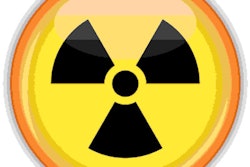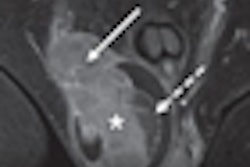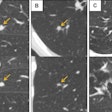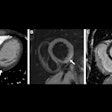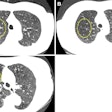The risks from testicular cancer far outweigh the radiation risk from CT exams used to diagnose and monitor it, concludes a study published today in Radiology. While the study was limited to testicular cancer, it illustrates a common mistake being made in estimating the risk of radiation from medical imaging exams.
Researchers analyzing a study of testicular cancer patients undergoing CT surveillance after surgery found that risks of radiation-bearing imaging scans are overestimated and overemphasized compared to the risks associated with the actual disease. This is because disease risk tends to be more immediate than long-term radiation risk, wrote a research team led by Dr. Pari Pandharipande (Radiology, December 18, 2012).
The investigators from Massachusetts General Hospital and Harvard Medical School evaluated the lifetime mortality risk of a prototypical 33-year-old man with early-stage testicular cancer, comparing it to the risk from CT surveillance of the disease in the years following orchiectomy.
Men with early-stage cancer undergoing CT surveillance incurred a slightly higher lifetime mortality risk from testicular cancer compared to potential radiation-induced cancers. However, because the testicular cancer risk was more immediate, the loss of life expectancy attributable to testicular cancer was more than three times greater than life expectancy loss attributable to radiation-induced cancers.
"Lifetime risk metrics, when used to compare risks that occur at different times in a patient's life, can lead to a practical overestimation of the effect of risks incurred later in life," wrote Pandharipande and colleagues. "In circumstances of CT referral, providers are commonly comparing proximal risks imparted by a disease with more distant radiation-induced cancer risks but are equipped only with lifetime radiation risk metrics."
The risk of harm from disease is often imminent; however, radiation risks can only be calculated long-term, leading to an apples-to-oranges comparison that underemphasizes disease risks in favor of radiation risks. This so-called "timing paradox," which distorts radiation-induced cancer risks among many stakeholders, suggests the need for additional research into the perception of risk to better understand its effect in clinical decision-making, according to the authors.
"Consider a scenario where a patient has a small risk of dying of a disease at -- or soon after -- the time of a CT scan, and an equal risk, based on a lifetime attributable risk estimate, of dying later in life of a radiation-induced cancer attributable to the CT examination," they wrote. "If a physician compares these risks directly, without taking into consideration the difference in timing, these risks may appear similar. However, if given the choice between equal risks of dying now versus dying several years from now, most patients would understandably choose the latter; these 'equal' risks are not equal."
The researchers used a Markov model to project outcomes in patients with testicular cancer who were undergoing CT surveillance for 10 years following orchiectomy. They compared the loss of life expectancy and mortality risks due to testicular cancer to life expectancy losses and lifetime mortality risks resulting from radiation-induced cancers from CT in order to quantify effects of early versus delayed risks in both scenarios.
Projecting life expectancy loss rather than lifetime risk estimates allowed the researchers to account for the timing of risks over the course of a lifetime, which, in turn, enabled them to evaluate the described limitation of lifetime risk estimates, they explained.
Radiation-induced cancer outcomes were projected based on the Biological Effects of Ionizing Radiation (BEIR) VII report, including the linear nonthreshold relationship between risk and exposure for solid tumors. Surveillance, Epidemiology, and End Results (SEER) registry data were used for background cancer incidence and mortality rates, and the CT schedules for surveillance were in line with National Comprehensive Cancer Network guidelines.
As an example of evidence yielded, 33-year-old men with stage I seminoma who were undergoing CT surveillance were projected to incur a slightly higher lifetime mortality risk from testicular cancer (598 per 100,000) than from radiation-induced cancers (505 per 100,000). However, life expectancy loss attributable to testicular cancer (83 days) was more than three times greater than life expectancy loss attributable to radiation-induced cancers (24 days). Trends were consistent across modeled scenarios.
"Our findings support the timing paradox; similar lifetime mortality risks from two different causes correspond to discrepant projections of life expectancy loss," the authors wrote. "Because testicular cancer deaths occur much earlier, they result in greater life expectancy loss relative to radiation-induced cancers, even when lifetime mortality risks are similar."
In a corresponding cohort of 33-year-old men with non-seminomatous germ cell tumors(NSGCT), the projected lifetime mortality risk was higher in the NSGCT group, at 2,243 per 100,000, compared with 262 per 100,000 for radiation-induced cancers. This was due to higher testicular cancer mortality associated with that form of the disease and lower requirements for CT surveillance.
Nevertheless, loss in life expectancy from testicular cancer, at 311 days, was far higher than the 12 days for radiation-induced cancers in this cohort. When chest CT was added to patients with NSGCT, lifetime mortality risk from testicular cancer dropped while radiation-induced cancers rose to 454 per 100,000, a life expectancy loss of 22 days, Pandharipande and colleagues wrote.
The timing paradox was more pronounced in younger versus older men, meaning that their loss in life expectancy (especially from testicular cancer versus radiation-induced cancer) was greater, according to the study team. Radiation risks dropped significantly among those who underwent only every other scheduled follow-up scan.
A very similar situation exists for Hodgkin's lymphoma, where mostly young patients undergo multiple CT scans for limited-stage disease, the group noted. Also, if MR were to emerge as an acceptable replacement for CT in testicular cancer surveillance, the risks of CT would be avoided entirely.
When lifetime risk metrics are used to compare risks that occur at different times in a patient's life, it can lead to overestimation of events that occur later in life, the authors concluded. This timing paradox mistake is common practice in medicine and shows how radiation-induced cancer risks can be distorted by different stakeholder groups. More research is needed into patient and provider risk perception, according to Pandharipande and colleagues.
"Radiation-induced cancer risks, often discussed at the population level, can be challenging to conceptualize and apply to imaging decisions that have to be made at the patient level," Pandharipande said in a statement accompanying release of the study. "We as physicians can benefit from dedicated educational efforts to improve decision-making and better convey the risks to patients."




